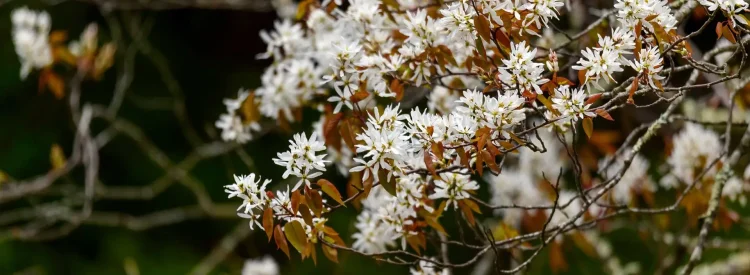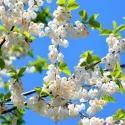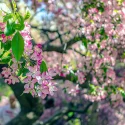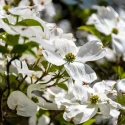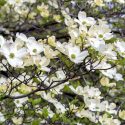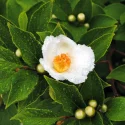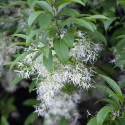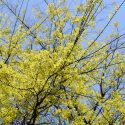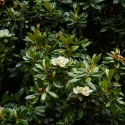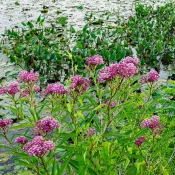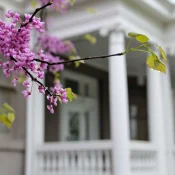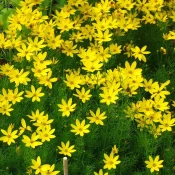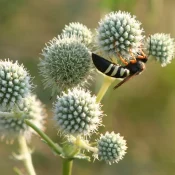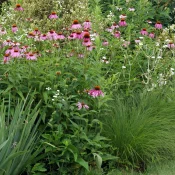You can plant a small tree with edible berries that taste like a cross between a blueberry and a raspberry. And not only that—it’s gorgeous year-round. In the spring, the tree is one of the earliest to flower with heavenly white bunches of delicate flowers. Enjoy snacking on its fruit in the summer. In the fall, its leaves turn fiery shades of orange and red. Serviceberries are so pretty—they are great for high-profile places like front yards. With around 30 species of serviceberry native to North America you have to ask: why are they not everywhere?
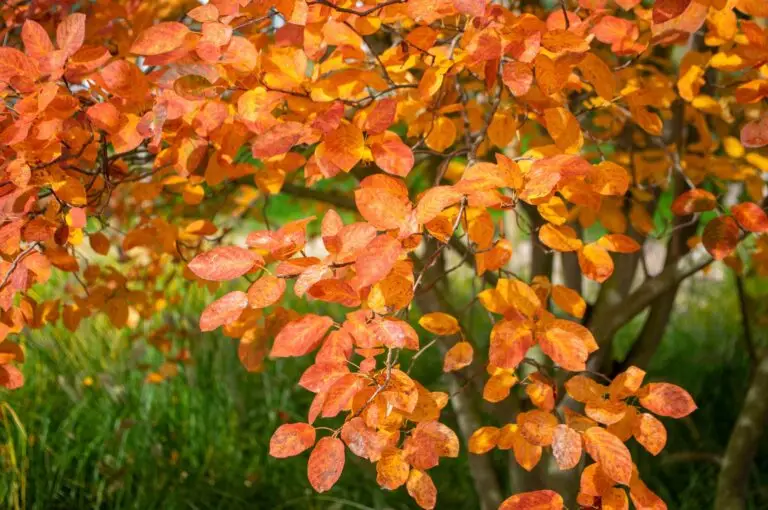
If you are a fan of flowering trees (and who isn’t?), we have a tree for you. Meet the serviceberry. There are around 30 serviceberry species native to North America, each specific to a region and climate. Each of these trees offers gorgeous flowers in the spring, edible fruit in the summer, and fiery leaves in the fall. They are a must-plant alongside other flowering favorites like native dogwoods, magnolias, redbuds, and fringe trees.
In this article, we’ll introduce a few serviceberry species, along with their growing regions and attributes.
Let’s start with what this tree delivers.
What are the benefits of planting a serviceberry?
Serviceberries are North American native plants. Native plants have grown in their home area for thousands—sometimes millions—of years. Their DNA carries ancestral knowledge of their area’s soil, weather, and climate.
Planting native plants like serviceberries makes our landscapes gorgeous while helping the birds, butterflies, and animals (and helping save us time.) Here are four reasons why planting a native plant like a serviceberry is worth it:
- Help wildlife: without native plants, iconic animals like songbirds won’t have the food or homes needed to survive
- Save time and money: after the first year of getting established, native plants are happy with rain.
- Enjoy resilient beauty. Serviceberries are a perfect example of how beautiful and resilient native plants are—they are always the best choice for our gardens.
- Delicious to birds and people. Serviceberry fruits are edible for birds and people alike.

Now that we’ve introduced its benefits, you might be wondering:
Why is it called serviceberry?
The name “serviceberry” comes from its connection to early American church services. In some regions, the plant would bloom in early spring, around the same time the ground thawed enough to hold burial services or when people could travel to attend church.
The USDA states, “in some regions, the flowers are gathered for church services, hence serviceberry.” You can imagine early colonists seeing these bright, blooming branches and bringing them in to cheer the gloom of early church structures.
It’s also sometimes called Shadblow or Shadbush
Serviceberries also go by the common name shadblow (or shadbush). This name originates from the timing of their blooms, which typically coincide with the annual spring migration of American shad fish from the Atlantic Ocean up rivers. Shad has been described as “the fish that fed the (American) nation’s founders.” Sadly, shad stock has plummeted in the past 100 years due to dams and overfishing.
Let’s introduce some serviceberries, hoping we can make them ubiquitous again.
Meet some native serviceberry species
There are around 30 native species of serviceberry, offering options to plant no matter where you live. Here are several species found throughout North America.
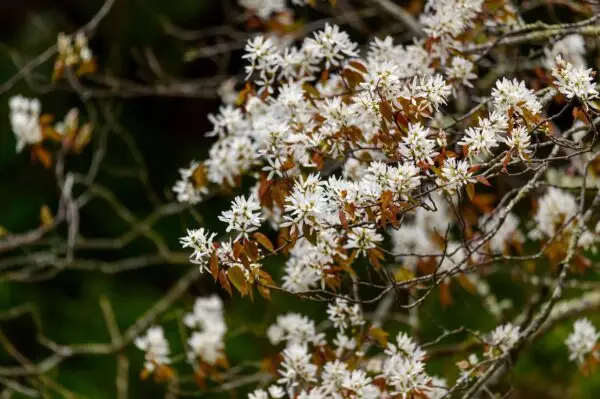
Downy Serviceberry
Amelanchier arborea
This is a tree for bird-lovers: 40+ bird species eat these berries. Downy Serviceberries are native to the entire eastern seaboard. They are called ‘downy’ because the undersides have a slightly fuzzy surface when their leaves first emerge.
Downy Serviceberries top out as a smaller tree at 30′ high, making them perfect for front yard, statement trees (they won’t get too tall and block your house.)
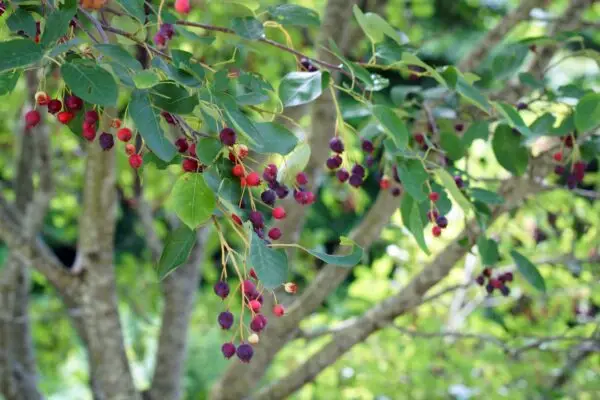
Canadian Serviceberry
Amelanchier canadensis
Canadian Serviceberries are one of the earliest plants to bloom in the spring. And contrary to its name, you can plant Canadian Serviceberries from Florida up to Canada—its native range is huge. Canadian Serviceberries get to be 20-30′ high.
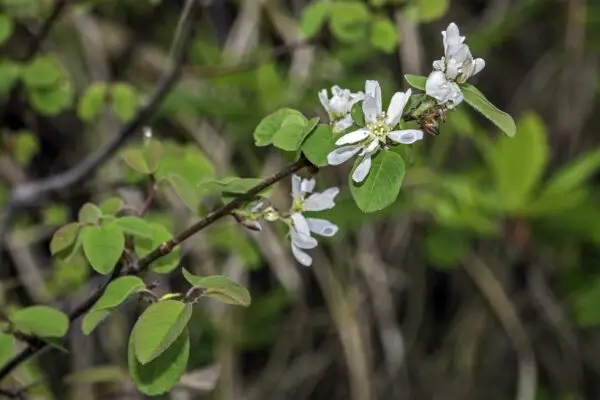
Utah Serviceberry
Amelanchier utahensis
This is a tough and beautiful native tree! Utah Serviceberries grow in canyons, stream edges, and ridges of the Southwest. They need just 10-20″ of water a year to thrive. Native Americans used the fruits in many different meals. If you live in the southwest, this is a special, beautiful tree to plant.
And that is just a few of the 30 species found in North America. (We’ll keep expanding the list.)
Now that you know there are so many serviceberry options, you might ask:
Which serviceberry species should I plant?
It may help to see some species maps to pick the one that is right for you. BONAP has a great overview of Amelanchier (aka serviceberry) species organized by regional maps.
We hope you’re excited to plant one of these native gems. If you are, you might now be asking:
Where can I find a native serviceberry?
Sadly, finding specific native plants can be challenging. Many conventional nurseries stock a majority of non-native plants (or native cultivars.) Big-box nurseries carry even fewer native options; it’s mostly just coneflowers or a heuchera.
We’re here to make finding a serviceberry much easier.
Here are four sourcing ideas for finding native serviceberries:
Where can I find seeds and plants?
Finding native plants can be challenging (we partly blame Marie Antoinette.) To make it easier, we’ve assembled four sourcing ideas.
300+ native nurseries make finding one a breeze
Explore 100+ native-friendly eCommerce sites
Every state and province has a native plant society; find yours
Online Communities
Local Facebook groups are a great plant source
What other native trees have flowers?
There are SO MANY unique native flowering trees that will put gardens in your skies. Unlike non-native flowering trees, the native trees of North America require minimal effort to thrive.
What are other edible native plants?
If you’re looking to eat from your garden, you’re in luck. There are lots of edible native plants. Some favorites include Hackberries, Pawpaw trees, and Highbush Blueberries. View more in our Edible Native Plants round-up.
To sum it up—serviceberries are a true unsung hero of North American trees and shrubs. Few plants offer the beauty, resiliency, and yummy treats that serviceberries do. Not only that, but plant one, and it will come back for generations. Planting native trees like serviceberries ensures that future generations and the iconic wildlife we love will have food and beauty for decades and decades. They deserve a spot in a highly visible place, which is why they’re on our Best Native Trees for Front Yards list. Happy planting!
Sources
- Mahr, Susan. “Serviceberry, Amelanchier Spp.,” University of Wisconsin-Madison, State Extension Horticulture, n.d.
- Nelson, Gil. Best Native Plants for Southern Gardens: A Handbook for Gardeners, Homeowners, and Professionals, (2010), 229-230.
- USDA, Downy Serviceberry Plant Guide, (PDF).
- USDA, Canadian Serviceberry Plant Guide, (PDF).
- USDA, Utah Serviceberry Plant Guide, (PDF).
- Wikipedia contributors. “American Shad.” Wikipedia, July 8, 2024.
- Boyle, Robert H. “A Sense of Where They Are.” The New York Times, December 8, 2002.
- “Amelanchier (Common Serviceberry, Downy Serviceberry, Juneberry, Saskatoon, Serviceberry, Shadblow, Shadbush, Sugarplum),” North Carolina Extension Gardener Plant Toolbox, n.d.
- Bonap.net. 2013 BONAP North American Plant Atlas, “Amelanchier TaxonMaps,” 2025.
- Iowa State Extention, Yard and Garden Blog. “Serviceberries,” June 5, 2024.
- U.S. National Park Service. “NETN Species Spotlight – Serviceberry,” 2020.
What if your feed was actually good for your mental health?
Give your algorithm a breath of fresh air and follow us.
